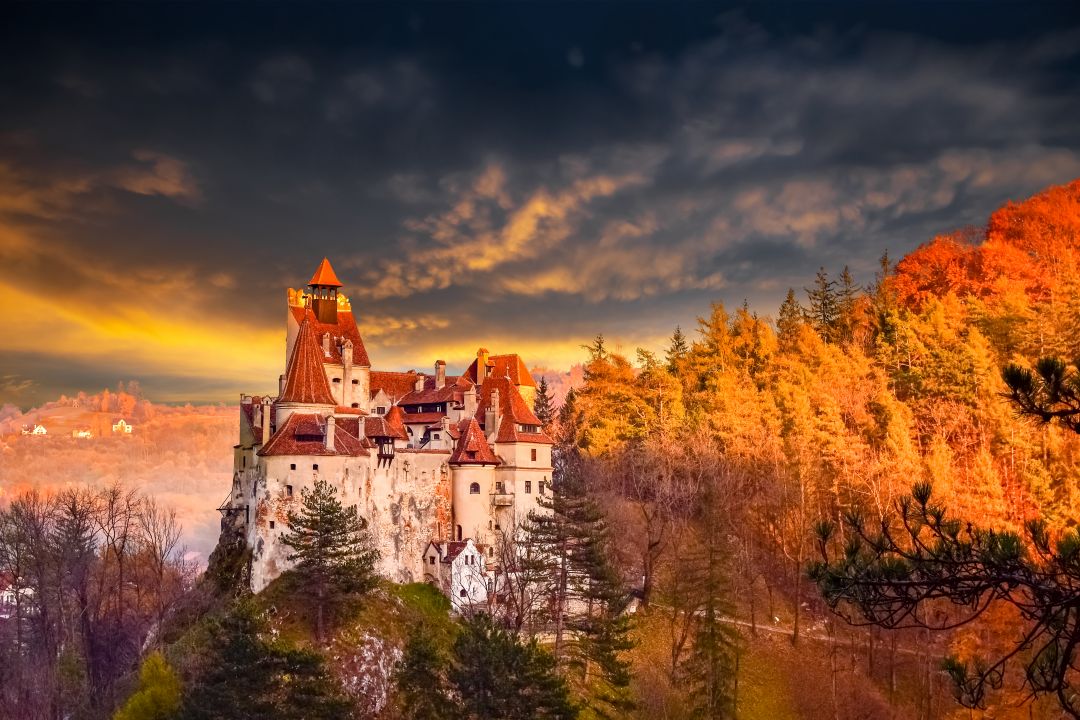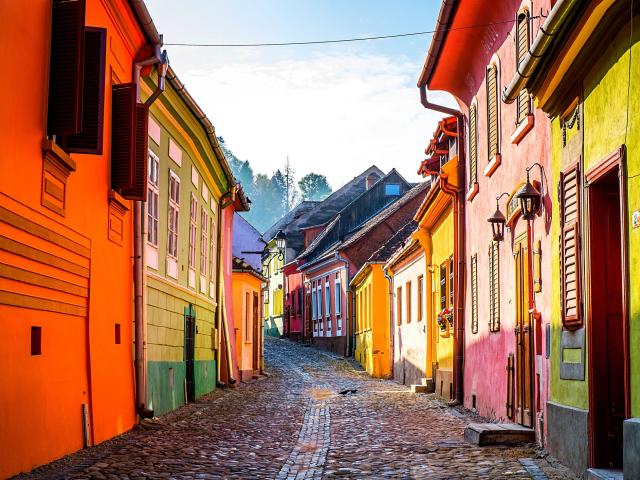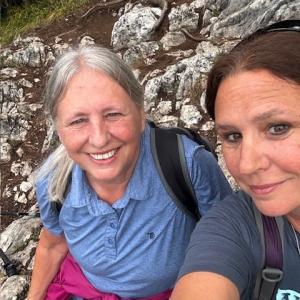










To view images fullscreen please turn device
Romania Tours & Holidays
Small Group Tours & Tailor-Made Holidays
Overview
European in character, Romania is nonetheless infused with a large twist of fairy tale. Filled with legends, castles, wolves and bears, its mountainous landscapes are dominated by the spectacular peaks of the Carpathians, which carve their way across the land, encircling the rolling Transylvanian Plateau in their embrace. Rural traditions are still very much a way of life here, with shepherd’s huts and haystacks dotting a landscape where the horse and cart is obviously the vehicle of choice. ...
European in character, Romania is nonetheless infused with a large twist of fairy tale. Filled with legends, castles, wolves and bears, its mountainous landscapes are dominated by the spectacular peaks of the Carpathians, which carve their way across the land, encircling the rolling Transylvanian Plateau in their embrace. Rural traditions are still very much a way of life here, with shepherd’s huts and haystacks dotting a landscape where the horse and cart is obviously the vehicle of choice. So close to home, and yet another world altogether, Romania is a real feast for the senses.
Away from the rural idyll and gastronomic bounty of the countryside, Romania’s dark history is a potent blend of myths and facts. The only Eastern Bloc country to end communism by executing its leader, this was also the birthplace of Vlad the Impaler, the brutal Wallachian prince on whom the legend of Dracula was loosely based. The influences of Romans, Saxons, Turks, Slavs, Gypsies and Hungarians have left in their wake some truly wondrous treasures including the medieval cities of Brasov and Sighisoara, as well as the spectacular painted monasteries of Bucovina,
For a truly unique insight into Romanian history and culture, why not stay with the widow and daughter of artist, Nicolae Popa. Part museum, part workshop, their home houses a beautiful collection of art, traditional costume, sculptures and artefacts that date from the Neolithic period to the time that Mr Popa spent in a communist jail.
Meet the Experts
Start your journey
Group tours
Travel to Romania with like-minded people on one of our small group tours (usually max size 12), featuring knowledgeable local guides and an expert tour leader.
Romania: Across The Carpathians To Transylvania
Make your way from UNESCO medieval painted monasteries, stunning mountain scenery and the rural delights of Viscri to the beautifully preserved historical centres of Sibiu, Brasov and Sighişoara on this journey of discovery through one of Europe’s most rewarding destinations.HIGHLIGHTS OF ROMANIA
BEST EXPERIENCES

Painted monasteries
See the elaborate 15th and 16th century frescoes painted on the walls of Bucovina's monasteries.

Saxon Viscri
Stay with one of the few remaining German colonists in Viscri in a refurbished Saxon peasant house and explore the village by horse drawn cart.
ROMANIA REVIEWS
Discover more
WHEN TO GO
LGBTQIA+ Guidance
When planning to travel as a member of the LGBTQIA+ community, there may be additional things you wish to consider doing, such as:
- Speaking to one of our travel experts for information about travelling in your chosen destination and local attitudes towards members of the LGBTQIA+ community
- Checking the Human Dignity Trust map which highlights regions and countries which are potentially dangerous to LGBTQIA+ people, or Equaldex, which tracks the progress of LGBTQIA+ rights around the world.
- Checking the ‘Local laws and customs’ section of your country's official foreign travel advice page
- Looking for any updates for your desired destination on the Human Rights Watch LGBTQIA+ rights page
- Buying a recommended guidebook, as many include an LGBTQIA+ section and advice for LGBTQIA+ travellers
USEFUL INFORMATION
Health and Vaccinations
There are no mandatory immunisations for travellers to Romania though you should be up to date with Typhoid, Tetanus, Polio and may consider boosters for Diphtheria and Hepatitis A. Please note we are not medical professionals and so we highly recommend you seek advice from your local GP or travel centre as to the correct immunisations and preventative treatments.
Currency
In Romania the official unit of currency is the Lei.
To check out the latest exchange rate for the places that you are visiting you can go to www.oanda.com.
Cultural Sensitivity
On our tours we frequently interact with local people, each with their own distinct customs and traditions. We therefore ask you to be considerate and to treat them with respect. Your guides will be able to advise you accordingly.
In churches and cathedrals women should cover their heads with a scarf or hat, while men should take their hats off.
Language & Religion
Romania’s official language is Romanian, an eastern romance language related to Italian, French, Spanish, Portuguese and Catalan. It is spoken by over 90% of the population and the most important minority languages are Hungarian and Vlax Romani. Being a secular state there is no official state religion, the dominant religious body being the Romanian Orthodox Church. Minority religions include other denominations of Christianity and a small community of Muslims, mostly of Turkish ethnicity concentrated in Dobrogea, and Jews.
Time
Romania is 2 hours ahead of GMT.
A useful website to check the time zone differences is www.worldtimezone.com.
Food and drink
Romanian cuisine has no doubt been shaped by the many waves of different cultures to occupy and embrace the country: from the ancient Greeks to the Saxons and their Slavic neighbours. The beloved, de facto national dish is ‘sarmale’ (pickled cabbage leaves stuffed with a mixture of minced meats, rice and spices). Other popular dishes include: ‘Tocanita’ or ‘tochitura’ (meat stew seasoned with onions and/or spices) and ‘mititei’ (The ‘Wee Ones’ — small skinless grilled minced meat rolls/ sausages).
Most meals will come with a first course of soup ‘ciorba’ with a variety to choose from, from the popular meatball soup ‘ciorbă de perisoare’ to tripe soup ‘ciorba de burta’. Whilst around the Black Sea or Danube Delta, ‘ciorbă de peste’ (fish soup) made with local fish is a must. Although meat is heavily prevalent in Romanian cuisine, there are a few options for vegetarians, such as ‘ghiveci’ (vegetable stew featuring up to 20 vegetables), ‘muraturi’ (red peppers, green tomatoes, cucumbers, carrots, red cabbage or cauliflower that has been pickled) and polenta known as ‘mamaliga’ which features as a popular side dish.
Travelling Solo In Romania
All of our small group tours are designed to cater for solo travellers: the number of solo travellers will vary from tour to tour, but usually over half will be travelling alone. Get all of the excitement of discovering new places combined with the security of travelling with an organised group, with like minded people.














